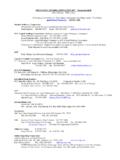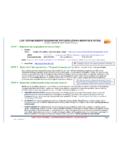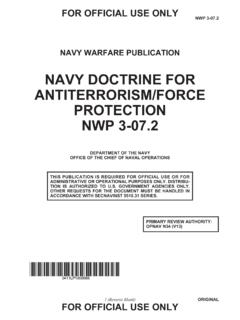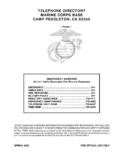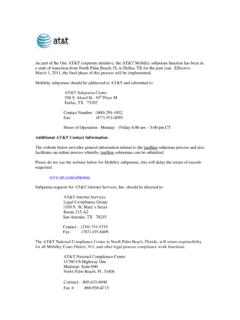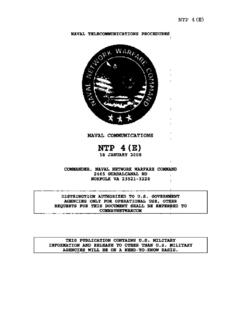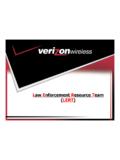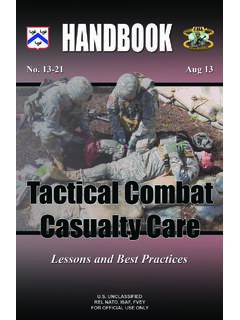Transcription of Rules of Engagement (ROE) Card Example Snap …
1 traffic control Point operations traffic control Point onerations Rules of Engagement (ROE) card Example Nothing on this card prevents you from using necessary and proportional force to defend yourself You may engage the following individuals based on their conduct: Persons who are committing hostile acts against Coalition forces (CF). Persons who are exhibiting hostile intenttowards CF. These persons may be engaged subject to the following instructions: Positive identification (PID) is required prior to Engagement . PID is a reasonable certainty that the proposed target is a legitimate military target. If no PID, contact your next higher commander for decision.
2 Use graduated measures of force. When time and circumstance permit, use the following degrees of graduated force when responding to hostile act/intent: 1. Shout verbal warnings to halt. 2. Show your weapon and demonstrate intentto use it. 3. Block access or detain. 4. Warning shots may be permitted in your operating environment (OE)/area of responsibility (AOR). 5. Fire proportional lethal force. Do not target or strike anyone who has surrendered or is out of combat due to sickness or wounds. Do not target or strike hospitals, mosques, churches, shrines, schools, museums, national monuments, any other historical and cultural sites, or civilian populated areas or buildings UNLESS the enemy is using them for military purposes or if necessary for your self-defense.
3 Do not target or strike Local infrastructure (public works, commercial communication facilities, dams), lines of communication (roads, highways, tunnels, bridges, railways), or economic objects (commercial storage facilities, pipelines) UNLESS necessary for self-defense or if ordered by your commander. If you must fire on these objects, fire to disable and disrupt rather than destroy. ALWAYS minimize incidental injury, loss of life, and collateral damage. The use of force, including deadly force, is authorized to protect the following: Yourself, your unit, and other friendly forces. Detainees Civilians from crimes that are likely to cause death or serious bodily harm, such as murder or rape.
4 Designated personnel or property, when such actions are necessary to restore order and security. In general, WARNING SHOTS are authorized ONLY when the use of deadly force would be authorized in that particular situation. Treat all civilians and their property with respect and dignity. Do not seize civilian property, including vehicles, unless the property presents a security threat. When possible, give a receipt to the property's owner. You may DETAIN civilians based upon a reasonable beliefthat the person: Must be detained for purposes of self-defense. Is interfering with CF mission accomplishment. Is on a list of persons wanted for questioning, arrest, or detention.
5 Is or was engaged in criminal activity. Must be detained for imperative reasons of security. Anyone you detain MUST be protected. Force, up to and including deadly force, is authorized to protect detainees in your custody. You MUST fill out a detainee apprehension card for EVERY person you detain. Looting and the taking of war trophies are prohibited. All personnel MUST report any suspected violations of the Law of War committed by any US, friendly, or enemy force. Notify your chain of command, Judge Advocate, IG, Chaplain, or appropriate service-related investigative branch. Snap TCP Example ~~ . ~---,~ Minimum: 50 meters ~ Identify and stop the target vehicle.
6 Cover vehicle and occupants with direct~fire weapons (watch following vehicles for indication of remote detonation of target vehicle). Maintain standoff and use a bullhorn or public address (PA) system to direct occupants out of the vehicle. Direct driver to open all doors, trunk, and hood. Use optics to inspect the vehicle from standoff position; maneuver, as required, to get the best angles. Move occupants away from vehicle; watch for suicide bomber (vest) indicators. Search/apprehend the occupants, if required. Refer to "look out" list and use vapor trace/X spray, leaflets to explain actions, and detainee/evidence kits. Inspect vehicle per TACSOP, if required, after optics inspection.
7 ~ Concertina ~wire XXXXXX Spikes Signs Counter Vehicle-borne Improvised Explosive Device Principles: TCP Drill: Maintain Standoff: 50 meter minimum. Maintain 360-0egree Security: You must be able to deal with approaching threats from all directions. Use Tactical Dispersion: Whether mounted or dismounted, do not bunch up. Employ Blast Protection: Use your vehicles, terrain, and man-made features to your advantage. Use EOF procedures to 10 threats: (" 5 S") SHOUT warning to stop (in local language and English); SHOW weapon; SHOW restraint or detain; SHOOT warning shot; and SHOOT to eliminate threat. Maintain communication with higher headquarters. Security: Ensure you maintain the right balance of inward and outward focus.
8 Separation: Use loudspeakers to instruct occupants to exit their vehicles and move away. Search: Clear the vehicle from a safe distance using optics. Only approach if necessary and with minimal fo rce. Set-up: Use speed and surprise to eliminate the enemy's ability to react. Conduct lED Check ("5-25") at Every Stop 5 Meter Checks 25 Meter Checks Identify a halt position. Conduct a visual/physical check for a 5-meter radius around your position. Check for disturbed earth and suspicious objects, such as loose bricks, etc. Start at ground level and scan upward. Be systematic; take your time and show curiosity. Patrol leader decides to occupy an area for more than 5 minutes.
9 Once 5-meter checks are conducted, continue scanning out to 25 meters and then move forward in teams for a 25-meter radius around your position, checking for potential improvised explosive device indicators and anything out of the ordinary. 2. 3. 4. 5. 6. 7. 8. 9. Recommended Snap TCP Equipment List ("A way": this list is NOT all inclusive) Signs: (2x) alert signs, (1x) warning sign, and (1x) 10. Signal pyrotechnics (star clusters), colored flags. stop sign. 11. Laminated search instructions, curfew violation (1x) stop paddle. warnings, contraband list, weapons policy guidelines, vapor trace/X-spray, and female (5x) sawhorses (folding), (10x) traffic cones, or search instructions.
10 (7x) warning triangles. 12. Personnel search wands (hand-held metal (5x) bean-bag lights or similar flashing/warning detector), crowbar/tanker bar/Halligan tool. lights. 13. Civilian jumper cables, tow chains, fire (3x) spike strips (to disable a vehicle), rolls of extinguisher. concertina wire, or similar vehicle-disabling device. 14. Pre-printed instructions in local language, leaflets to explain actions. (1x) portable speed bump or field expedient substitute (sandbags, etc.). 15. (20x) detainee forms and (20x) evidence forms. Flashlights (2 per screening team and search 16. Digital camera. team). 17. (20x) zip ties/handcuffs/flex cuffs. Search mirrors/optics, binoculars, infrared illuminators, night-vision devices, telescopic 18.

